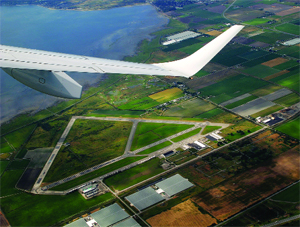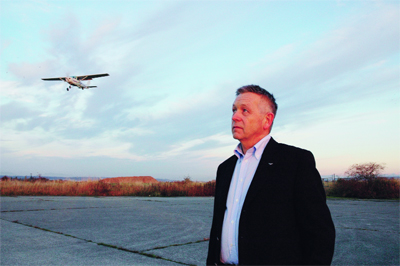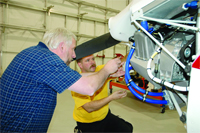
Features
Operations
The Transformation of Boundary Bay: Once forgotten, the future looks bright
For too many years, Boundary Bay Airport was something of a forgotten asset. A former WWII-era training base, closed after the war, reopened years later, and then finally sold by Transport Canada to Delta Municipality for a single dollar.
January 30, 2008 By Matthew Lang
 |
| Contracted to develop the Boundary Bay Airport by Delta Municipality in 2004, Fred Kaiser, founder and owner of Alpha Technologies, has already put $10 million into rejuvenating the airport. (Photo by Richard Austen, courtesy of Boundary Bay Airport Operators) |
For too many years, Boundary Bay Airport was something of a forgotten asset. A former WWII-era training base, closed after the war, reopened years later, and then finally sold by Transport Canada to Delta Municipality for a single dollar. But what was, or should have been, a grand opportunity to create a business climate for general aviation and other so-called across-the-street industries was basically squandered by the company contracted to develop that asset. The airport suffered years of neglect, the results of a sour relationship between the municipal government and the same management company contracted to operate the airport on the city’s behalf.
As the airport’s facilities degraded over time, the question of how to fix the problem was given up by those who needed it to be fixed, as well as those who were in a position to do the fixing. A general acceptance of the status quo slowly settled in and operators, primarily flight schools and students, adjusted their activities to accommodate the defacto standard. And so things were, for several years until push-came-to-shove, and the municipal government took action to reclaim the airport and vacate its contract with the management company. In 2004, after the company refused to pay back property taxes, the municipality took the airport back from it and began looking at its own options.
During those years as the airport’s facilities were declining, that same question of how to fix it was becoming of interest to Fred Kaiser, founder and owner of Alpha Technologies, a multinational multimillion-dollar company which, among other things, develops high technology electric back-up systems for the cable tv industry. Kaiser, himself a pilot and dedicated aviation enthusiast, spoke to many of the pilots and operators at Boundary Bay Airport, and saw not only the potential opportunity that was present, but indeed, the underlying need to develop that asset in the first place.
Crucial to the long-term success of any airport are three things: Lots of money, a solid plan, and then lots more money. This, more than anything else, is where Fred Kaiser has separated himself from previous operators of the airport. Contracted to develop the Boundary Bay Airport by Delta Municipality in 2004, Kaiser has already put $10 million into rejuvenating the airport, he has a plan for current and future developments, and he is willing to invest more of his own money if he can get some help from the government. Gordon Andrews, Alpha Aviation’s Manager of Airport Operations, calls Kaiser the saviour of Boundary Bay Airport, if for no other reason than he has finally been able to provide that confidence necessary for those in government to put public money into the airport as well.
 |
| Alpha is betting that Boundary Bay’s location, just south of Vancouver, will prove to be a key selling point to the corporate world. Pictured here is Gordon Andrews, Alpha Aviation’s Manager of Airport Operations. |
But Andrews says Delta’s municipal government was at first reluctant to get involved with the new operation. It had just come out of a lengthy and unhappy relationship, and the last thing it wanted was to start putting limited public money right back into the airport, especially since it wasn’t even developing its own tax base yet.
Delta Mayor Louis Jackson remembers the problems from the previous operation very well, and has nothing but praise for Alpha Aviation’s management of the airport. Jackson remembers the airport from the days before it was reopened by Transport Canada, and the only remaining hangar from the old training base was being used as an ice skating rink where her son played hockey. Today, that hangar is being renovated and will be a heritage building housing a museum which will pay honour to those who trained at the airport during the war.
Like most things involving government, various com-munity interests, and a multitude of special interest groups, each with their very own perspective on the airport’s future (or even its hoped-for demise), the complications of managing Boundary Bay Airport seem endless.
 |
| Halcyon Aviation, owned by Ray Firkus and Peter Schlieck, recently completed Canada’s first jet fuel/diesel conversion on a Cessna 172. |
Andrews regularly finds himself caught between com-peting interests, but Alpha Aviation has stuck with the plan. “They did the right thing,” says Mayor Jackson, referring to the initial public meetings organized by Alpha specifically to involve those differing interests and look for solutions. “It’s an interesting process, and hopefully you only have to go through it once or twice,” said Andrews.
This most recent rebirth of Boundary Bay Airport has seen environmentalists, farmers, neighbouring residents and businesses, local government, and several federal government agencies all demanding one contradictory thing or another.
Andrews recalls being directed by two federal ministries at the same time to devise a wildlife management plan: one to specifically prevent birds from becoming a safety problem to aircraft, and the other to protect birds from being disturbed by aircraft. Boundary Bay Airport sits on the shore of its namesake, a major stopover point for several migratory bird species, a few endangered species, and a multitude of predatory birds which are part of a government-sponsored breeding program and live just a few feet from the end of one of the busiest runways in Canada.
Among the first projects undertaken by Alpha were a new, large corporate-style six-bay maintenance and business hangar, and a major runway lengthening to better accommodate business jets. Add some additional aircraft parking spaces, a new taxiway here and there, and the $10 million committed by Alpha could run out in a hurry. In fact, Alpha has already spent more than that, and Andrews says it isn’t slowing down.
Andrews stresses that this is not a philanthropic venture by Alpha’s owner. “We’ve done a lot of brainstorming – what is our market even without the Olympics (in 2010)” he said. Corporate aviation will play a significant role in that market. Andrews points to the recent trend of increases in fractional ownership, and development of Very Light Jets, adding that corporate jets are no longer a luxury but a necessary tool. It all points to a world where corporate aviation will find a comfortable home at Boundary Bay Airport.
Opened in February 2007, the new hangar was filled by April and now has a waiting list. Heli-One, the maintenance arm of CHC Helicopter Corp., is building a new 235,000-square-foot test and repair facility. It is by far the largest development of any kind to be seen at the airport since it was built. “Soon this will be an industrial airport,” said Andrews.
Alpha is betting that its location, just south of Vancouver, will prove to be
a key selling point to the corporate world – close enough to Vancouver, yet with significantly lower operating costs than YVR.
Mayor Jackson also sees a bright future at ZBB. “Alpha has been very good to our community. The transition is new and exciting, and it is going to generate a lot of good paying jobs and bring a lot of tax revenue to the community.” And the jobs and businesses are already coming to Boundary Bay. From fractional ownership, start-up airlines, and high-tech maintenance companies to very small flight training schools to the multimillion-dollar consolidation of Heli-One’s operation, Boundary Bay Airport is drawing many new companies for a couple of very simple reasons.
David Lai, general manager of Sea Land Air Management, a fractional ownership and time share company which does flight training, chose to open its new half-million dollar operation at Boundary Bay Airport because of the airport’s new facilities. Lai, a helicopter and fixed-wing pilot, looked at the other airports in the Greater Vancouver area before he selected Boundary Bay. His decision was based on what Andrews insists are the airport’s strongest assets. Lai says the airport’s proximity to Vancouver and the potential for growth in business aviation were both major factors in helping him decide to open at Boundary Bay. The longer runway was also a consideration as Sea Land Air hopes to move into the Very Light Jet (VLJ) market as well.
“The timing is right, now,” said Lai. He had wanted to start his company five years ago, but had difficulty finding good quality space. Today, he is also trying to follow the philosophy of the airport by keeping things new. He is bringing in new Diamond Katanas for flight training, and Sea Land Air has vowed not to bring in any 30-year-old airplanes to teach in. “It’s like a comparison between Avis and rent-a-wreck,” says Michael Peare, the CFI at Sea Land Air. “Avis won’t rent you a 30-year-old car, and we won’t rent you a 30-year-old plane.”
In the space right next to Sea Land Air is Halcyon Aviation, owned by Ray Firkus and Peter Schlieck. Halcyon chose to open its third and newest repair and maintenance operation at Boundary Bay for the same reasons as their neighbour, namely the pro-growth opportunities that result from Alpha’s development plans.
And Halcyon is another example of a company interested in new technology. It recently completed Canada’s first jet fuel/diesel conversion on a Cessna 172. Using the Thielert Centurion engine, Halcyon has been fielding phone calls on a near-daily basis from pilots wanting to upgrade to the biggest innovation that GA has seen in light aircraft engines in many decades.
Schlieck sees the operation at the new facility as being a bit more expensive compared to other airports, but feels the potential for doing more turbine maintenance is a great opportunity. With only two turbine aircraft currently based at Boundary Bay Airport, Schlieck says there will be a dramatic change in three to four years. And with two new airlines now starting up scheduled and on-demand charter service at Boundary Bay, it is likely the changes will indeed be dramatic.
Schlieck is also aware of some operators at the airport who have already made deposits on a VLJ, which only adds to the interest in being at the airport. Schlieck says it’s all good for business. “You can’t compete on everything. Different tenants bring different things to the table,” he says, adding that even other direct competitors to Halcyon would be good for business, bringing more customers and more business for everyone at the airport.
Michael Coughlin calls this the “synergy of co-location.” Coughlin is vice-president of business units for Heli-One and is very familiar with this idea. It is one of the driving forces behind Heli-One’s move to Boundary Bay Airport. Coughlin explains that “Heli-One has built up through (company) acquisitions, and its time to bring it all together.” Heli-One’s new test and repair facility will be capable of overhauling and testing four turbine engines at the same time, while its hangar can hold up to 20 helicopters. Coughlin says this will give Heli-One the ability to offer a level of tip-to-tail maintenance which is rare in the helicopter MRO industry.
And Heli-One is spending a sizable amount on its facility. Coughlin says the construction budget for the new hangar alone is $30 million, and that does not include the inside investment in tooling the facility with such things as a new paint booth, engine test beds, avionics shops, CNC machines, etc.
The move by Heli-One will bring 300 people to the airport, “with plans to hire additional staff starting next year (2008) which could see double that without any problem,” says Coughlin.
Because of the new management of Boundary Bay Airport, opportunities are being created where there were only lost opportunities before. New technology is coming in to replace old, and it is only a matter of time for the driving force at the airport, which currently comes from Alpha Aviation, to be completely self-sustaining.
But right now, with over $10 million already spent, and a seemingly endless need for more money, Gordon Andrews and the staff at Alpha Aviation have their hands full. Future projects like a new main terminal building set to begin construction soon, and a new apron to replace the badly cracked 1960s apron, GPS approaches, and … well, a lot more things are still on the list and a lot more money is needed. The good news – the confidence needed to get the money and to get the job done are firmly in place, and it is only a matter of time for the rest to follow.
Matthew Lang is a freelance writer and photographer in BC, and his photos can be viewed at www.MatthewLangPhoto-graphy.com.